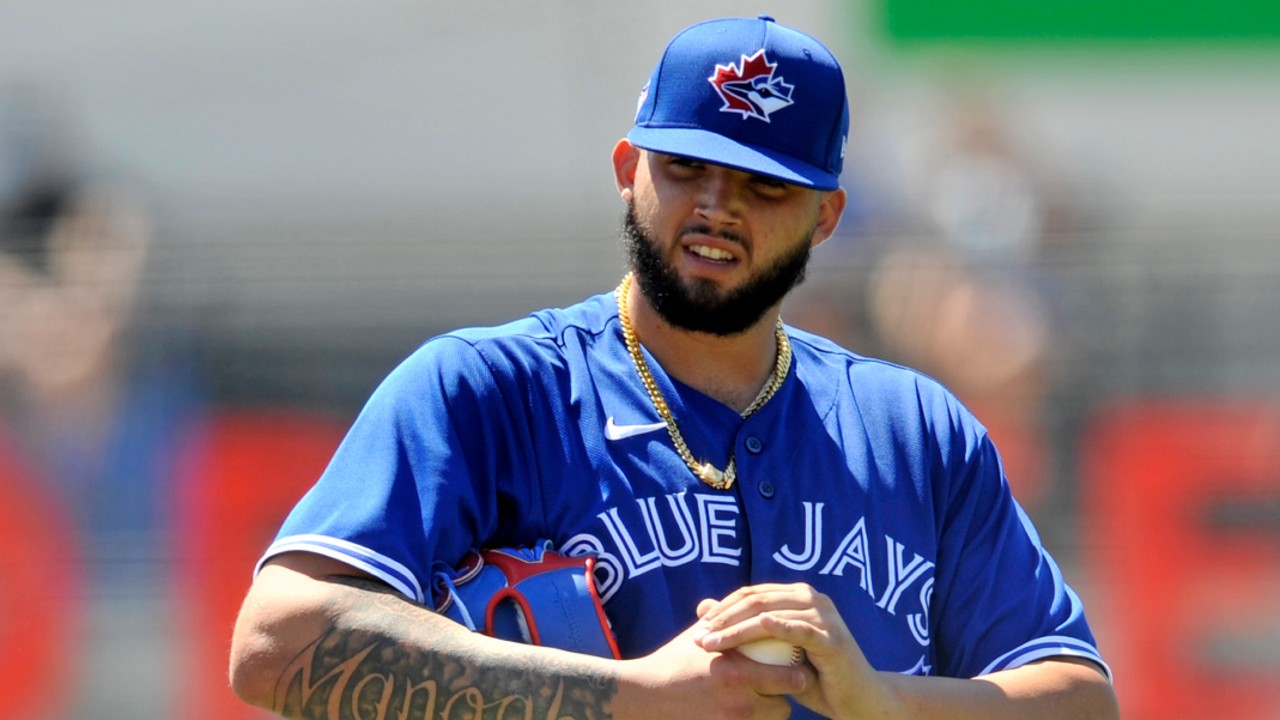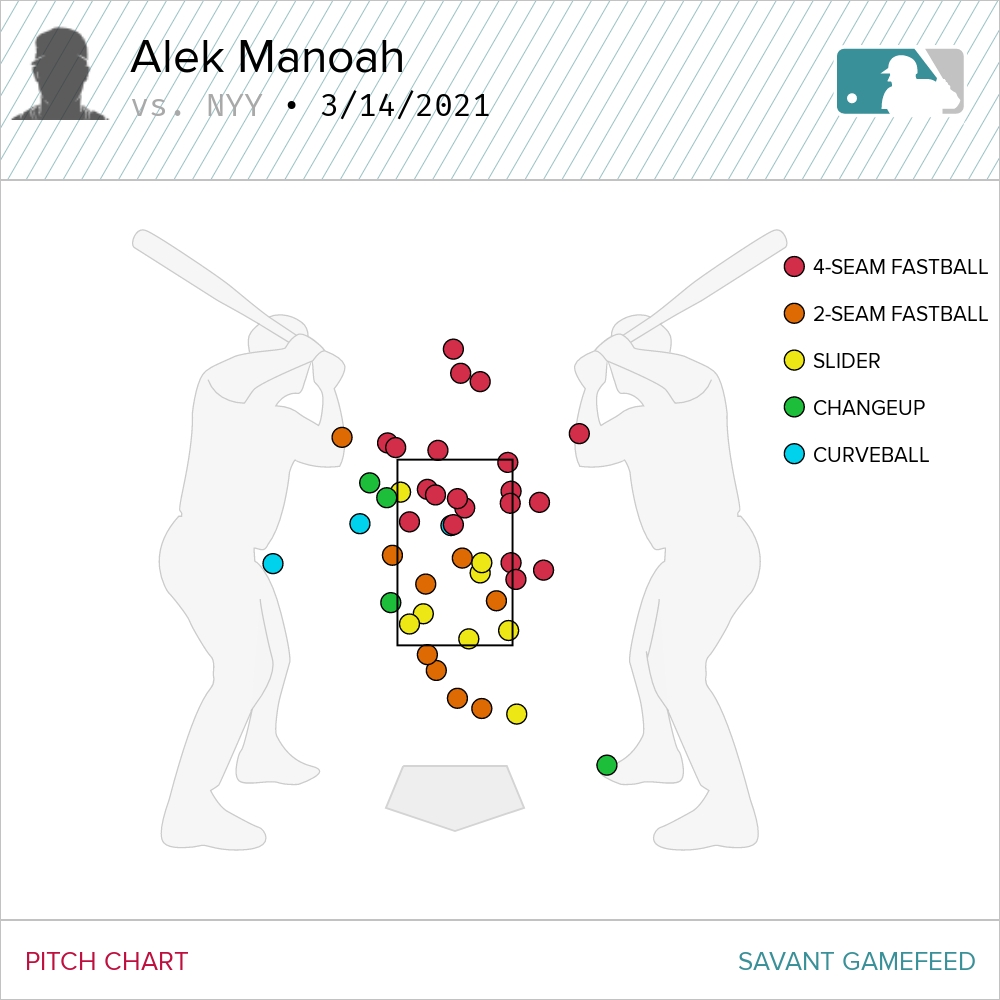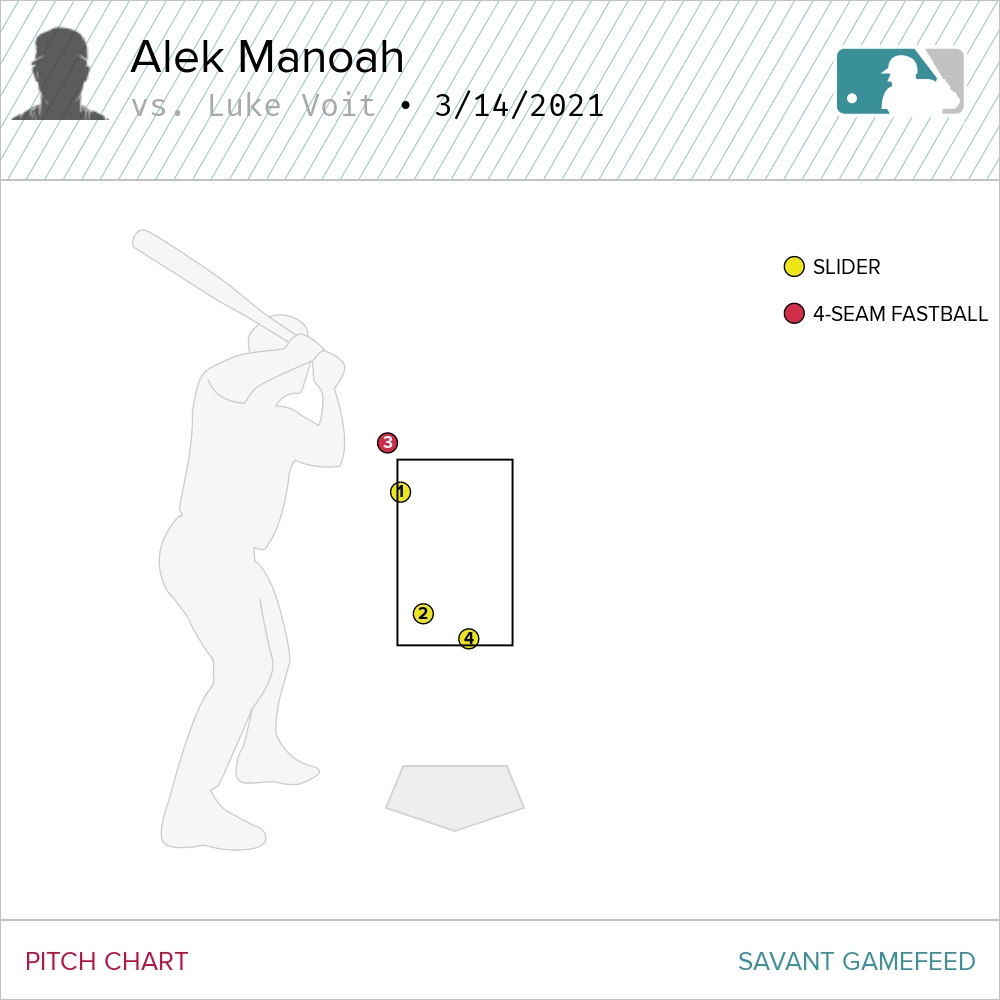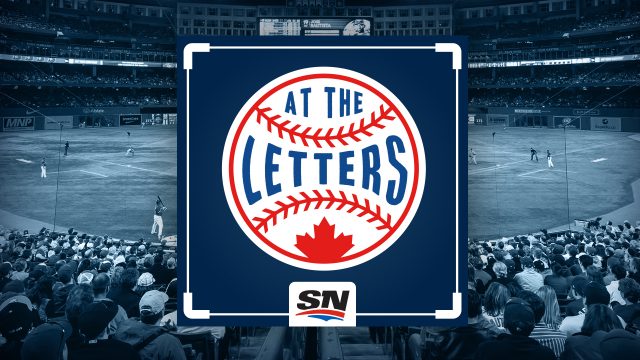
When Alek Manoah faced the New York Yankees in his spring debut a week-and-a-half ago, more than two-thirds of the pitches he threw were fastballs. And why not? Manoah throws his heater 95 m.p.h. — touching 98 when he needs to — at around 2,500 revolutions per minute, which would rank within MLB’s top-30 fastball spinners. It’s a massive pitch. And he rode it that day to four strikeouts over two scoreless innings against the Yankees’ A lineup.
But as he prepared to face New York for a second time in as many appearances Sunday, Manoah wanted to provide a different look. After all, starting pitchers can’t approach the same teams in the same fashion every time they face them. These days, video and information is too abundant. Major-league hitters are too good. They catch on quick.
So, in his pre-game meeting with catcher Reese McGuire, Manoah decided he’d show the Yankees a few fastballs early to get their bats sped up, before working in a steady diet of his secondary weapons — an adaptable slider and a diving change-up — to catch them off balance.
“Obviously, it starts with the fastball. That’s the foundation,” Manoah said. “But being able to open up the plate and throw the other pitches, it really keeps me in a good rhythm and just gives me options.”
Those finer points in his approach, those adjustments he’s making start to start, inning to inning, pitch to pitch, are what makes the 2019 first-round pick such a promising prospect for the Blue Jays. He’s not just throwing — he’s pitching. And at his best, he’s doing both.
That’s how it all came together in Sunday’s spectacular outing as Manoah was perfect over three innings of work, at one point striking out seven consecutively. The two balls he allowed in play were both on the ground, as Yankee hitters were consistently late or off-balance against whatever Manoah was throwing.
“His two outings have been just outstanding, He seems in control, he’s not nervous. He’s ready to attack the hitters,” said Blue Jays manager Charlie Montoyo. “It’s one of those where his line shows what he did. It wasn’t just luck. He just dominated today. And he did the other day, too, the last time he pitched against the Yankees. That was fun to watch.”
Manoah’s mid-90s fastball was still dominant, as he dotted it all over the zone for called strikes, swinging strikes, and foul balls. But this time around, he mixed in his secondary stuff at will, getting five swinging strikes with a slider he can manipulate to make slower and sweepier to generate whiffs, or faster and tighter to land in the zone for called strikes.
That slider can look so different depending on how much English the big right-hander puts on it that whoever was monitoring the pitch data gathered by TrackMan at TD Ballpark in Dunedin identified several of them as curveballs, a pitch Manoah doesn’t throw.

“Giving the hitters different looks is always going to be important,” Manoah said. “Some guys might go up there and think heater. And then when you throw a slider first pitch, it just gives them that thought in the back of their mind. And that’s really all we need as pitchers — is just hitters to second guess.
“You know, you’ve got like point-four seconds to react to a pitch. So, if you’ve got them second-guessing, it’s going to make that point-four seconds a lot quicker. Just the fact that I can keep hitters off first pitch, being able to mix in change-ups and sliders, and not always heaters, I think what that does is help me help them second guess and make them miss some pitches.”
That’s everything the Blue Jays want to hear, and everything they’ve been preaching throughout Manoah’s development since drafting him out of West Virginia University two years ago. In college, Manoah could overpower swing-happy hitters who couldn’t catch up to his fastball and waved at his slider. Now, facing professionals, he has to be more cunning.
And Sunday was a great example. During his run of sitting down seven consecutive Yankees, each of Manoah’s strikeouts was different from the last, as he used a variety of patterns and sequences to keep hitters unsure of what exactly they were about to see.
“That’s what impressed me the most today,” Montoyo said. “To be successful in the big leagues, that’s what you need to do. We all know he can throw 97, 98. But if you can throw your breaking pitches for a strike like he did today, the sky’s the limit for that kid.”
It began in the first inning as Manoah peppered the zone with sliders against Luke Voit, landing one for a called first strike before getting the Yankees first baseman to swing over two more towards the bottom of the zone.

Then he went after Jay Bruce with fastballs, dotting one perfectly on the inside black for a called first strike and elevating another at the top of the zone to get weak foul contact. His eye level elevated and bat sped up after the barrage of heaters, Bruce swung right through a firm, tight slider on the plate above his knees to end the inning.
Manoah started his second frame with that slider, this time dropping a sweepier, slower one into the zone for a called strike against Clint Frazier before tunnelling a fastball perfectly off of it for another. Two pitches later, Manoah blew a 95.4-m.p.h. heater past the Yankees outfielder to ring him up.
Derek Dietrich was next, and he gave Manoah a good battle, fouling off a pair of fastballs and a slider. So, with his sixth pitch of the plate appearance, Manoah reached back for his third offering, locating a hard, 88.4-m.p.h. change-up on the outside black that Dietrich swung right over.

“You know, sometimes the heater can either be the put-away pitch or it can be the setup pitch. And, in that case, that’s what it was,” Manoah said. “We kept going to heaters in and up, and he was just slightly missing it. And Reese at the perfect time called the change-up and I was able to execute. It worked out perfect.”
As Kyle Higashioka stepped in, Manoah tried again to land that first-pitch strike slider he started Frazier with, but missed inside. Facing a hitter’s count, Manoah didn’t show any fear, challenging Higashioka with a 95-m.p.h. fastball on the plate that the Yankees catcher swung right through. Then Manoah came back with a sinker on the inside black for a called second strike before getting Higashioka to chase a slider on the outside black to end the inning.
In the third, Manoah powered a 95 m.p.h. first-pitch fastball past Tyler Wade, before knocking him down with another heater up-and-in. After brushing himself off, Wade worked the count full for the first time in Manoah’s outing, but couldn’t resist chasing a plummeting slider beneath the zone.

Then Thairo Estrada nearly got hit himself, as Manoah lost the handle on a first-pitch breaking ball. But three of the next four pitches were fastballs on the edges of the strike zone — one Estrada fouled off, another he took for a strike, and a final one he swung right through.
Manoah worked up-and-down against Estrada in a similar fashion to the way he did against Bruce, using a slider at the bottom of the zone and fastballs at the top to adjust the third baseman’s eye level. The difference this time was the slider set up swing-and-miss with the fastball, as opposed to vice versa when Manoah got Bruce.
“I actually complimented him in the dugout about his location when we did elevate. He didn’t spray any too high that were almost a waste of a pitch. He was dialled in and hitting his spots,” McGuire said. “For me back there, blending those two and also mixing in the change-up — he executed beautifully.”
That change-up is absolutely crucial to Manoah’s development, and will likely prove a fulcrum between whether his career progresses as a starter or reliever someday. Manoah’s fastball and slider are so advanced, and his mindset is so determined, that he could almost certainly get high-leverage outs pitching as a reliever for the Blue Jays on opening day. But the ideal outcome in his development isn’t effective relief — it’s dominant starts. It’s taking the ball every fifth day and getting at least twice through a lineup, maybe more if he’s efficient.
And in order to do that, Manoah will need a third pitch he can locate for strikes. If he doesn’t have it, hitters will simply hunt his fastball and foul off sliders on the plate. That a change-up is one of the hardest pitches to learn how to command effectively is a challenge Manoah will have to rise to. While catching Manoah’s bullpens and live BPs throughout camp, McGuire’s seen it on good days and bad. Sunday, he thought it was as good as it’s ever been.
“Mixed it in to some of the lefties, even to a couple of the righties. He was throwing everything for a strike,” McGuire said. “Man, he was on a mission out there today.”
It’s worth remembering how difficult this all is. Manoah’s last start in a game that counted was more than 18 months ago in August 2019, when he struck out eight over four scoreless for the Vancouver Canadians. He got work in at Toronto’s alternate site last year; he got work in at home in Miami with his brother, Erik, who spent six seasons in the minors himself. But he hasn’t felt the emotional rush of real, live competition in an awfully long time. That’s one thing to manage for a major-league veteran, it’s another for a 23-year-old who’s played in only a half-dozen professional games.
Manoah says he felt it in his first live bullpen this spring, when the Blue Jays chucked him right into the deep end against George Springer, Marcus Semien, and Bo Bichette. It was like his body and mind were moving at different speeds. He’d think about how he had to slow down his breathing, control his heart rate. But his body wasn’t responding.
His next time on the mound was against the Yankees on the road, facing hitters like DJ LeMahieu and Giancarlo Stanton, who he’d only ever seen on TV. Then, on Sunday, the Blue Jays put him up against the Yankees again. Not quite New York’s A lineup, mind you, but big-leaguers nonetheless. There has been little time to adjust.
“We have routines as pitchers and we go through things that keep us level-headed and keep us focused. But the moments can get big, you know? And, naturally, our emotions will rise with them,” Manoah said. “But as games go on, your body gets familiar with, ‘Oh, this is what that feels like again.’ And then you’re able to control it more. So, yeah, it’s been very exciting since my last outing — super excited to be back out there. And I’m glad my body’s starting to listen to me again.”
There’s certainly no questioning his mindset. And no questioning the results. Manoah’s now struck out 11 of the 16 batters he’s faced this spring. He’s given up a single, hit Aaron Judge, and gotten groundball outs from everyone else. Manoah won’t be on Toronto’s opening day roster. But performances like Sunday’s go a long way to showing the Blue Jays what he could offer at some point later in the season if the club’s battling the Yankees — Toronto plays New York seven times in September — for playoff positioning.
You’d presume that having dominated those same pinstriped hitters over his first two spring outings would only help his confidence if that September scenario materializes. You’d be wrong.
“It does nothing for my confidence,” Manoah said. “But it absolutely excites the seven-year-old kid inside of me that grew up watching the Yankees. For me, it’s just an exciting moment. And hopefully there’s more of them.”






